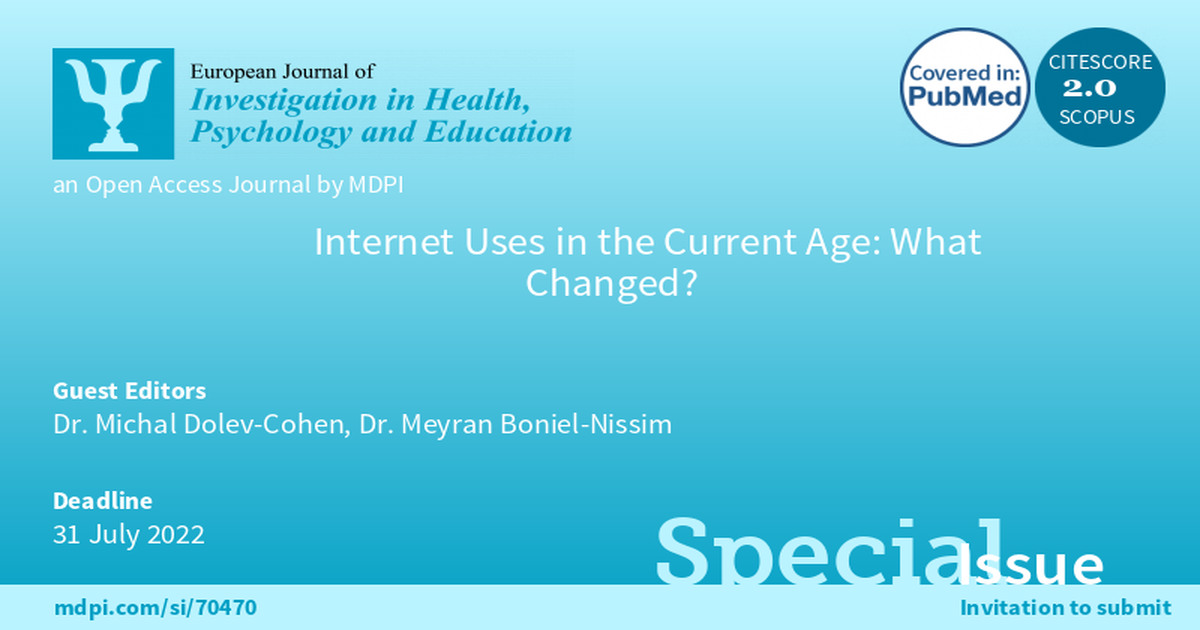Internet Uses in the Current Age: What Changed?
A special issue of European Journal of Investigation in Health, Psychology and Education (ISSN 2254-9625).
Deadline for manuscript submissions: closed (31 July 2022) | Viewed by 33955

Special Issue Editors
Interests: cyber psychology; teachers in the digital age; online risk behavior
Special Issue Information
Dear Colleagues,
Internet use is known to have implications for physiological, emotional, cognitive, and social aspects. Findings concerning Internet use present positive aspects as well as negative aspects.
However, today, in the context of the worldwide COVID-19 outbreak, it is expected that Internet use will increase, as it is as a tool for learning, communicating, and leisure, especially for those who have experienced sustained lockdown. During this period the internet became a major tool in many lives, including for youngsters, adults, and the elderly. Many populations that did not typically use the Internet intensively had to start using it more (because of work tasks, online learning, etc.). Thus, it is important to examine the consequences of using the Internet today (during or after the lockdown). One main question that arises: Is it possible to find differences in the consequences of using the Internet in the current period compared to that before the COVID-19 pandemic outbreak?
This Special Issue calls for the submission of manuscripts related to Internet use (smartphone use, apps, social networks, etc.) during the COVID-19 pandemic outbreak and its effects on different aspects (physiological, emotional, cognitive, social, and family aspects).
Dr. Michal Dolev-Cohen
Dr. Meyran Boniel-Nissim
Guest Editors
Manuscript Submission Information
Manuscripts should be submitted online at www.mdpi.com by registering and logging in to this website. Once you are registered, click here to go to the submission form. Manuscripts can be submitted until the deadline. All submissions that pass pre-check are peer-reviewed. Accepted papers will be published continuously in the journal (as soon as accepted) and will be listed together on the special issue website. Research articles, review articles as well as short communications are invited. For planned papers, a title and short abstract (about 100 words) can be sent to the Editorial Office for announcement on this website.
Submitted manuscripts should not have been published previously, nor be under consideration for publication elsewhere (except conference proceedings papers). All manuscripts are thoroughly refereed through a single-blind peer-review process. A guide for authors and other relevant information for submission of manuscripts is available on the Instructions for Authors page. European Journal of Investigation in Health, Psychology and Education is an international peer-reviewed open access monthly journal published by MDPI.
Please visit the Instructions for Authors page before submitting a manuscript. The Article Processing Charge (APC) for publication in this open access journal is 1400 CHF (Swiss Francs). Submitted papers should be well formatted and use good English. Authors may use MDPI's English editing service prior to publication or during author revisions.
Keywords
- Internet use
- COVID-19
- Social networks
- Smartphone use
- Problematic internet use
- Online communication
- Online learning
- Special populations
- Psychological aspects
- Age and gender differences







